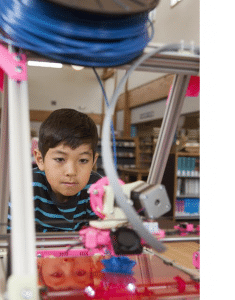Celebrating National Manufacturing Day | October 7, 2016
 The first Friday in October is celebrated as National Manufacturing Day, where we commend those who have made American products with passion and
The first Friday in October is celebrated as National Manufacturing Day, where we commend those who have made American products with passion and
determination. These are the same people who have inspired the upcoming generation of students to become further educated on developing the future. As we enter the fourth industrial revolution which will focus on the integration of data and communication, companies are focusing on skills, continued innovation, and setting new standards to drive the next generation.
So where does Fisher Unitech see manufacturing heading for the future? I asked Danny Levy, a 3D printing Application Engineer who works with our manufacturing customers, what his thoughts were on the topic. His insights were inspirationally optimistic.
“The future of manufacturing is all around us. As someone who entered the industry from the realm of open-source prototyping, my understanding is that the future will lie in the realization that fabrication technology is not so binary – but a spectrum of relatively similar tools which serve a relative purpose. The opportunity to satisfy customers will be based on responsive platforms which facilitate communication and collaboration between vendors, customers, consumers and even machines. The commodification of digital systems is greatly influencing the decentralization (and flexibility) of manufacturing environments, which will mean more opportunities out there for local manufacturers. Industry 4.0 is in full swing.”
At Fisher Unitech, we believe in the power of our products, and 3D printing has improved the processes of thousands of companies to save time and money when producing their designs. So how has manufacturing changed 3D printing (or perhaps, how has 3D printing changed manufacturing)?
“Some people have characterized 3D printing as a “disruptive technology”. Ultimately this has become a distraction for potential adopters of additive manufacturing. For many small to medium sized businesses, having to restart with new (and potentially unproven) processes from scratch is a risk they can’t take. This has caused the need to provide would-be adopters with an enhanced understanding of 3D printing tools so that they realize the adoption of these processes does not mean reinventing the wheel, but rather shortcuts to obtain their designs quicker, cheaper and with less human effort.”
Trends for the near future could go a few different ways, whether it is with automation, sensors, 3D printers, or data and analytics, our engineer has his own opinion of where the future of manufacturing will be trending in the job industry.
“My best guess would that job trends would regard materials, such as metallurgy, or possibly radio frequency engineering since mobile communication play such a large role in our daily lives.”
So now that we’ve seen a look into the future of manufacturing, we should also consider what engineers are experiencing in the present. What is it like to be an engineer today?
“As an Application Engineer at Fisher Unitech, it is unbelievably exciting to be front and center to the large and small challenges that our customers are looking to address. What many people don’t realize is that customer cases often drive new industry-wide applications. As an engineer, I have the opportunity to innovate on a daily basis.”
We’ve looked into the future and the present of manufacturing in America, so as our generation continues to evolve we should encourage our youth to engage and help develop the future of manufacturing.
“Young minds of the future should look at manufacturing because there will be a demand for highly skilled, fresh thinkers in localized manufacturing roles. You do not have to go to a four-year college to be a brilliant professional in the manufacturing space. Machine operators and skilled trade technicians will be increasingly important to companies that want to be more vertical with manufacturing technology. Our future will be built on automation and artificial intelligence, and we will need the workforce to implement and support these systems.”
Industry 1.0 was the adoption of steam power, 2.0 electricity, and 3.0 brought in automation and the internet. From the very beginning, each revolution made leaps and bounds never thought possible. Now that we are approaching industry 4.0, technology has proven endless possibilities to improve our company’s, productions, and our lives. Have we exceeded the expectation?
“I’m not much of a historian but I do like sci-fi. Science is often motivated by the aspirations of sci-fi. Similarly, historic predictions often become self-fulfilling prophecies. We shape the future we envision.”
Danny Jackson Levy has a background in Industrial Design and has been with Fisher Unitech as a 3DP Application Engineer since 2015. He has further examined application trends and growth in additive manufacturing in his webcast and enjoys working directly with customers. He is based in Chicago, Illinois.
About the Author:
Angelle Erickson writes about how companies are using innovative technologies, such as 3D printers and SOLIDWORKS software to increase productivity, improve product development processes, and maximize business potential.

 Blog
Blog